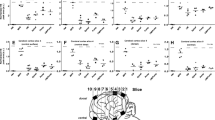Abstract
The pharmacokinetics of the polyethylene glycol-conjugated form of the enzymel-asparaginase and the depletion ofl-asparagine from the plasma and cerebrospinal fluid (CSF) following an i.m. dose of 2500 IU/m2 PEG-l-asparaginase was studied in rhesus monkeys. PEG-l-asparaginase activity in plasma was detectable by 1 h after injection and maintained a plateau of approximately 4 IU/ml for more than 5 days. Subsequent elimination from plasma was monoexponential with a half-life of 6±1 days. Plasmal-asparagine concentrations fell from pretreatment levels of 14–47 μM to <2 μM by 24 h after injection in all animals and remained undetectable for the duration of the 25-day observation period in four of six animals. In two animals, plasmal-asparagine became detectable when the PEG-l-asparaginase plasma concentration dropped below 0.1 IU/ml. Pretreatment CSFl-asparagine levels ranged from 4.7 to 13.6 μM and fell to <0.25 μM by 48 h in five of six animals. CSFl-asparagine concentrations remained below 0.25 μM for 10–14 days in four animals. One animal had detectable CSFl-asparagine concentrations within 24 h and another had detectable concentrations within 1 week of drug administration despite a plasma PEG-l-asparaginase activity profile that did not differ from that of the other animals. These observations may be useful in the design of clinical trials with PEG-l-asparaginase in which correlations among PEG-l-asparaginase pharmacokinetics, depletion ofl-asparagine, and clinical outcome should be sought.
Similar content being viewed by others
References
Abuchowski A, Kazo G, Verhoest C, Van Es T, Kafkewitz D, Nucci M, Viau A, Davis F (1984) Cancer therapy with chemically modified enzymes: I. Antitumor properties of polyethylene glyco-asparaginase conjugates. Cancer Biochem Biophys 7:175–186
Asselin B, Ryan D, Frantz C, Bernal S, Leavitt P, Sallan S, Cohen H (1989) In vitro and in vivo killing of acute lymphoblastic leukemia cells byl-asparaginase. Cancer Res 49:4363–4368
Capizzi R, Bertino J, Skeel R, Creasey W, Zanes R, Olayon C, Peterson R, Handschumacher R (1971)l-Asparaginase: clinical, biochemical, pharmacological, and immunological studies. Ann Intern Med 74:893–901
Cooney D, Handschumacher R (1970)l-Asparaginase andl-asparagine metabolism. Annu Rev Pharmacol Toxicol 10:421–441
Cooney D, Capizzi R, Handschumacher R (1970) Evaluation ofl-asparagine metabolism in animals and man. Cancer Res 30: 929–935
Department of Health Education and Welfare (1988) Publication. 84–23 National Institutes of Health, Bethesda, Maryland (revised)
Haley E, Fischer G, Welch A (1961) The requirement forl-asparagine of mouse leukemia cells L5178Y in culture. Cancer Res 21: 532–536
Ho D, Brown N, Yen A, Holmes R, Keating M, Abuchowski A, Newman R, Krakoff I (1985) Clinical pharmacology of polyethylene glycoll-asparaginase. Proc Am Assoc Cancer Res 26:152
Ho D, Brown N, Yen A, Holmes R, Keating M, Abuchowski A, Newman R, Krakoff I (1986) Clinical pharmacology of polyethylene glycoll-asparaginase. Drug Metab Dispos 14:349–352
Ho D, Lin J, Brown N, Covington W, Newman R, Krakoff I (1987) Polyethylene glycoll-asparaginase andl-asparaginase studies. Proc Am Assoc Cancer Res 28:419
Ho D, Wang C-Y, Lin J-R, Brown N, Newman R, Krakoff I (1988) Polyethylene glycoll-asparaginase andl-asparaginase studies in rabbits. Drug Metab Dispos 16:27–29
Jones B, Pääbo S, Stein S (1981) Amino acid analysis and enzymatic sequence determination of peptides by an improvedo-phthaldialdehyde precolumn labelling procedure. J Liq Chromatogr 4:565–586
Knott G (1979) MLAB — a mathematical modelling tool. Comput Methods Programs Biomed 10:271–280
McCully C, Balis F, Bacher J, Phillips J, Poplack D (1990) A rhesus monkey model for continuous infusion of drugs into cerebrospinal fluid. Lab Anim Sci 40:522–525
Miller H, Salser J, Balis M (1969) Amino acid levels followingl-asparagine amidohydrolase (EC.3.5.1.1) therapy. Cancer Res 29: 183–187
Milman H, Cooney D (1974) The distribution ofl-asparagine synthetase in the principle organs of several mammalian and avian species. Biochem J 142:27–35
Ohnuma T, Holland J, Freeman A, Sinks L (1970) Biochemical and pharmacological studies with asparaginase in man. Cancer Res 30: 2297–2305
Park Y, Abuchowski A, Davis S, Davis F (1981) Pharmacology ofEscherishia coli l-asparaginase polyethylene glycol adduct. Anticancer Res 1:373–376
Riccardi R, Holcenberg J, Glaubiger D, Wood J, Poplack D (1981)l-asparaginase pharmacokinetics and asparagine levels in cerebrospinal fluid of rhesus monkeys and humans. Cancer Res 41: 4554–4558
Author information
Authors and Affiliations
Rights and permissions
About this article
Cite this article
Berg, S.L., Balis, F.M., McCully, C.L. et al. Pharmacokinetics of PEG-l-asparaginase and plasma and cerebrospinal fluidl-asparagine concentrations in the rhesus monkey. Cancer Chemother. Pharmacol. 32, 310–314 (1993). https://doi.org/10.1007/BF00686177
Received:
Accepted:
Issue Date:
DOI: https://doi.org/10.1007/BF00686177




